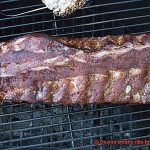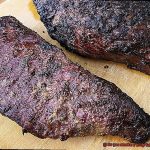Thanksgiving is just around the corner, and your taste buds are probably already tingling at the thought of a succulent, mouthwatering turkey. But when it comes to smoking your Thanksgiving bird, there’s one question that has puzzled cooks for generations: do you smoke a turkey legs up or down? It’s a debate that’s been raging in kitchens across America for ages, with each side claiming that their method is the only way to achieve perfectly cooked meat and crispy skin. So what’s the answer – legs up or legs down?
In this post, we’re going to delve into this age-old debate and explore the science behind both methods. We’ll cover everything from the anatomy of a turkey to the role of gravity in cooking, all with one goal in mind – helping you create a juicy and delicious bird that will be the star of your Thanksgiving table.
Whether you’re an experienced smoker or a novice cook, we’ve got you covered with all the tips and tricks you need to make this year’s Thanksgiving feast unforgettable. By the end of this article, you’ll have all the information you need to decide whether legs up or legs down is right for your bird.
So get ready to discover some amazing hacks that will help elevate your turkey game and impress your guests. Whether you prefer classic flavors or bold new twists on tradition, we’ve got everything you need to make this year’s Thanksgiving dinner an absolute triumph.
Contents
Factors to Consider When Deciding Whether to Smoke a Turkey Legs Up or Down
Smoking a turkey is an art form, and one of the most debated topics is whether to smoke it with the legs up or down. The decision is not always straightforward, and several factors must be considered to achieve the perfect bird.
One key factor is the size of the turkey. If you have a smaller turkey, smoking it legs down is recommended. This allows for more direct heat to reach the thighs and drumsticks, ensuring even cooking throughout the bird. Conversely, larger turkeys should be smoked legs up to ensure that the heat penetrates through the thickest part of the bird for better browning and crisping of the skin on top.
The type of smoker being used is also important. In a vertical smoker with the heat source at the bottom, smoking the turkey legs up is recommended for better air circulation around the bird and to prevent flare-ups caused by drippings falling onto the heat source. However, in a horizontal smoker with the heat source on one side, smoking the turkey legs down may be a better choice to ensure even cooking throughout the bird.
Personal preference is another factor to consider when making this decision. Some prefer crispy skin all over and may choose to smoke their turkey legs up. Others prioritize even cooking throughout the bird and may choose to smoke their turkey legs down. Experimenting with both methods can help you find what works best for your taste preferences.
To ensure that your turkey is fully cooked and safe to eat, use a meat thermometer to monitor its internal temperature. This eliminates guesswork and ensures that your bird is cooked to perfection.
Pros and Cons of Smoking a Turkey with Legs Up
Smoking a turkey is a culinary art form that requires skill, patience, and a willingness to experiment with different methods. One of the most hotly debated issues in the world of smoked turkey is whether to cook it with its legs up or down. As an expert in this field, I have delved into the research to share with you the pros and cons of smoking a turkey with its legs up.
Let’s begin with the positives of smoking a turkey with its legs up. First and foremost, this method allows for better moisture retention. As the juices collect in the breast area, it keeps the meat moist throughout the cooking process, resulting in a tender and succulent bird. Second, cooking the turkey with its legs up ensures even cooking as the heat is distributed more evenly throughout the bird. Thirdly, smoking a turkey with its legs up makes for a better presentation when serving as it keeps the bird’s shape intact, impressing your guests.
However, there are also cons to consider when smoking a turkey with its legs up. First, this method may result in longer cooking times as the heat takes longer to penetrate the thickest part of the bird – the thigh. Second, smoking a turkey with its legs up can lead to uneven browning as the breast area may cook faster than the thighs. Finally, smoking a turkey with its legs up may result in drippings pooling in one area, making it difficult to collect them for making gravy.
In conclusion, both pros and cons exist when smoking a turkey with its legs up. Ultimately, it depends on personal preference and your cooking style. If you’re after juicy meat and even cooking, smoking your turkey with its legs up might be your best bet. However, if you’re looking for crispy skin and shorter cooking times, smoking your turkey with its legs down could be your preferred method.
To summarize:
Pros:
- Better moisture retention
- Even cooking
- Better presentation
Cons:
- Longer cooking time
- Uneven browning
- Drippings pooling in one area
Pros and Cons of Smoking a Turkey with Legs Down
Firstly, one of the most significant advantages of smoking a turkey with legs down is that it results in even cooking. The heat circulates evenly around the bird, ensuring that the breast meat does not dry out while the dark meat is cooked thoroughly. This method also helps retain the natural juices, making the meat juicier and more flavorful. Who doesn’t love a succulent, juicy turkey?
Moreover, smoking a turkey with legs down provides a better presentation. The bird sits evenly on its platter, making for an impressive centerpiece at your Thanksgiving feast. It’s all about the presentation.
However, there are some cons to consider as well. Smoking a turkey with legs down can result in slower cooking times since the heat has to penetrate through the thigh bone to cook the dark meat thoroughly. This may mean that you need to plan for a longer cooking time than if you were smoking with legs up. Additionally, the skin on the underside of the turkey may not brown as evenly as the skin on top, which could impact your presentation.
Lastly, there is a risk of overcooking the breast meat if it is left in the smoker for too long. Since the dark meat takes longer to cook, it’s important to keep an eye on your cooking time to avoid this issue.
Tips for Smokers Using Either Method
When it comes to smoking a turkey, there are two popular methods
smoking with the legs up or smoking with the legs down. Both methods can lead to mouth-watering results, but it’s important to keep a few tips in mind for the best outcome. Here are five sub-sections of tips for smokers using either method:
Thaw and Brine Your Turkey
Before smoking your turkey, make sure it’s properly thawed. This can take several days, so plan ahead. Once it’s thawed, consider brining it for added flavor and moisture.
Legs Up Method
If you opt for the legs up method, be aware that this can result in uneven cooking. Dark meat cooks faster than white meat, so use a meat thermometer to monitor both parts of the bird and adjust cooking times accordingly. Additionally, make sure your turkey is secure on the smoker rack to prevent any wobbling or tipping.
Legs Down Method
For those who prefer the legs down method, make sure the turkey is securely positioned on the rack to prevent uneven cooking or even a dropped turkey. Use twine to tie the legs together at the ankles and monitor the internal temperature to ensure safe consumption.
Choose the Right Wood Chips or Chunks
Regardless of which method you choose, use wood chips or chunks that complement the flavor of turkey, such as apple or hickory. This can add an extra layer of depth and complexity to your finished product.
Let Your Turkey Rest
Once your turkey is done smoking, let it rest for at least 15-20 minutes before carving. This allows the juices to redistribute throughout the bird and results in a more flavorful and moist end product.
Different Types of Smokers and Their Benefits
Smoking a turkey is a time-honored tradition that has been passed down for generations. For the perfect smoked turkey, it is essential to choose the right type of smoker. There are various types of smokers available on the market, each with its unique benefits. Let’s take a closer look at each type and its advantages when it comes to smoking turkey.
Electric smokers are an excellent choice for beginners or those who want to smoke their turkey indoors. They are incredibly easy to use and require minimal maintenance. With a thermostat that can be easily adjusted, electric smokers offer precise temperature control, ensuring your turkey cooks evenly. Additionally, electric smokers are known for their convenience, allowing you to set it and forget it while your turkey slowly smokes to perfection.
Charcoal smokers are another popular option among smoking enthusiasts. These smokers use charcoal as fuel and offer a rich, smoky flavor that many people enjoy. While they require more skill to operate than electric smokers, the flavor is worth the effort. To ensure consistent cooking, it’s important to closely monitor the temperature throughout the smoking process.
Pellet smokers are versatile and easy-to-use, making them an ideal choice for smoking turkey. These smokers use wood pellets as fuel and offer precise temperature control. They also use less fuel than other types of smokers, making them cost-efficient in the long run. Pellet smokers are perfect for those who want to experiment with different flavors, as they can be used with a range of wood pellets.
Finally, propane gas smokers are perfect for those who want a quick and easy smoking process. These smokers heat up quickly and require minimal effort to maintain the desired temperature. They are also larger than other types of smokers, making them ideal for smoking larger items like turkeys. However, some people find that propane gas smokers don’t offer the same depth of flavor as other types of smokers.
How to Monitor the Internal Temperature of the Turkey
Smoking a turkey is an art, and to perfect this art, you must monitor the internal temperature. The internal temperature of the turkey is a crucial factor in determining whether it’s cooked through, safe to eat, and delicious. Here are five sub-sections that explain how to monitor the internal temperature of the turkey:
Choose the Right Thermometer

The first step in monitoring the internal temperature of your turkey is to choose the right thermometer. Instant-read thermometers and leave-in thermometers are two types of meat thermometers available in the market. Instant-read thermometers provide quick readings within seconds and are great for spot-checking the temperature. Leave-in thermometers remain in the turkey throughout the cooking process and provide continuous readings.
Insert the Thermometer Correctly

After choosing your thermometer, it’s essential to insert it correctly into the thickest part of the turkey without touching any bones. Touching bones can give a false reading, leading to uncooked or overcooked turkey. To ensure even cooking, check the temperature in multiple places.
Monitor Temperature Regularly
It’s vital to monitor the temperature regularly throughout the cooking process, especially during the last hour when the temperature can rise quickly. This will help you avoid overcooking or undercooking your turkey.
Let It Rest
Once your turkey reaches an internal temperature of 165°F (74°C), remove it from the smoker and let it rest for at least 15 minutes before carving and serving. Resting allows for the juices to redistribute throughout the meat, resulting in a juicier and more flavorful bird.
Experiment With Positioning
Whether you smoke your turkey legs up or down is a matter of personal preference and experimentation. Placing your turkey legs up can help prevent the skin from sticking to the grates or racks, making it easier to maneuver when checking the temperature.
How to Achieve Optimal Results from Smoking a Turkey
Smoking a turkey is a time-honored Thanksgiving tradition that requires careful consideration of several factors to achieve optimal results. One such factor is the position of the turkey during smoking – legs up or down? Let’s explore the differences between these two methods and how to get the most out of each.
Legs Up: Juicier Breast Meat
Smoking a turkey with its legs up can result in a juicier and more tender breast meat as the juices from the thighs and legs flow down to baste it while cooking. This method is especially helpful for those who prefer moist meat.
Legs Up: Less Likely to Dry Out
When smoking a turkey with its legs up, the thighs protect the legs from getting overcooked and drying out. This helps to keep the bird moist and juicy while smoking, which can be challenging when smoking poultry.
Legs Down: Even Cooking
Smoking a turkey with its legs down is a great way to ensure even cooking throughout the bird. This position allows better airflow around the thighs and legs, preventing any undercooked or overcooked spots on the bird.
Legs Down: Crispy Skin
When smoking a turkey with its legs down, the legs are more exposed to direct heat, which can help to crisp up the skin and give it a beautiful golden-brown color. This can make for an aesthetically pleasing presentation at the dinner table.
Experimentation is Key
The decision of whether to smoke a turkey legs up or down ultimately depends on personal preference and experimentation. It’s recommended to try both methods and determine which one yields the best results for your taste buds and equipment setup.
Other Factors to Consider
Besides the position of the turkey during smoking, other factors also play a crucial role in achieving optimal results when smoking a turkey. Proper seasoning, brining, smoking at the correct temperature and time, and using a meat thermometer to monitor the internal temperature of the turkey are all essential.
Conclusion
As the age-old question of whether to smoke a turkey legs up or down continues to perplex many, it’s important to remember that there is no one-size-fits-all answer. While some swear by the legs-up method for more even cooking and juicy meat, others argue that legs-down allows for better browning and crispier skin.
Ultimately, it comes down to personal preference and experimentation. Don’t be afraid to try both methods and see which one yields the results you desire. Factors such as the size of your turkey, type of smoker being used, and desired outcome all play a role in determining which approach is best suited for your bird.
To ensure your smoked turkey turns out perfectly every time, it’s crucial to monitor its internal temperature regularly using a reliable meat thermometer. And don’t forget about letting it rest before carving – this will help retain its juices and enhance its flavor.
Choosing the right smoker can also make all the difference in achieving mouthwatering results. Whether you opt for a traditional wood-burning smoker or a high-tech electric model, make sure it fits your needs and preferences.
With these tips and tricks in mind, you’ll be well on your way to creating an unforgettable smoked turkey that will wow your guests this Thanksgiving.






